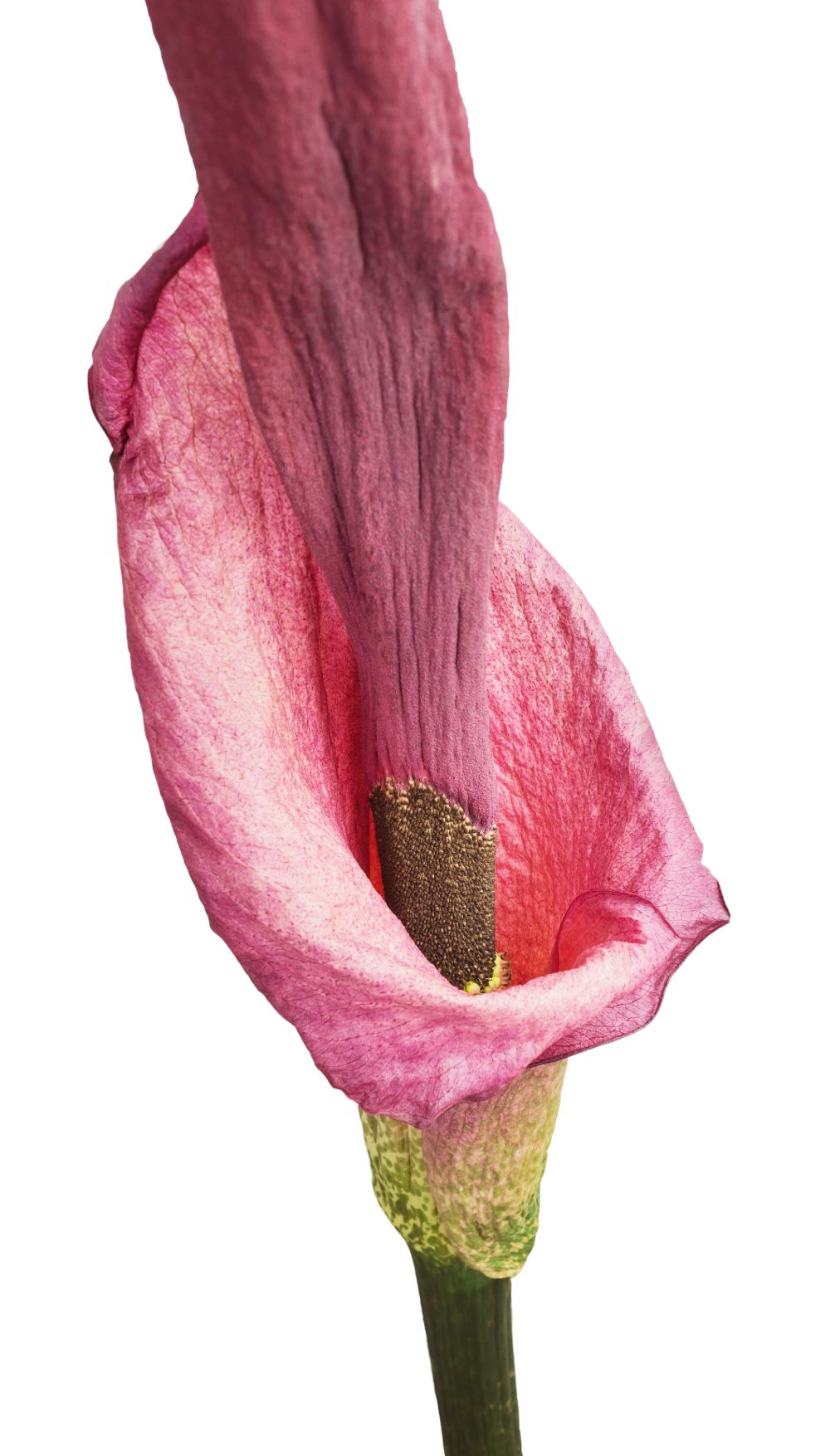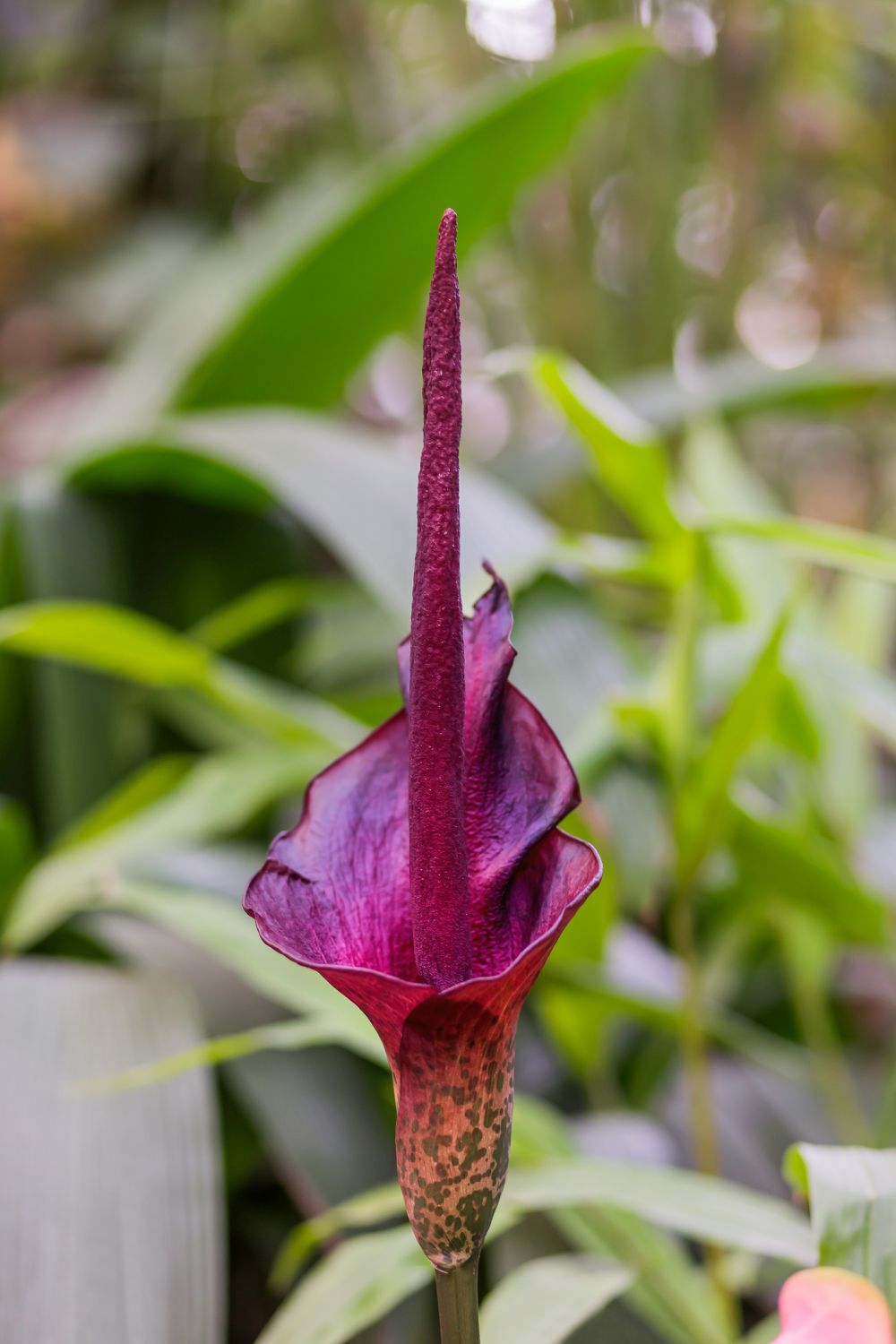Voodoo Lily Care: How To Grow And Care For A Voodoo Lily Bulb
A voodoo lily is a must-have houseplant whether you believe in magic or not. Although the plant has a long and rather dark history in association with voodoo and spills, you shouldn’t hold that against it. This is all in the past anyway. Since then, the voodoo lily has cleaned up its act and has settled nicely in its new role as a purely ornamental houseplant. Rather than cause havoc with dark spills, it simply enchants with its sublime beauty and saucy charm.
That doesn’t mean you can’t use it for black magic if you’re so inclined. The innocent voodoo lily that grows magically out of a bulb without even the need for soil is ready to please. How you make use of it is really up to you.
So if you’re curious about this bulb and how to grow it, you’ve come to the right place. This article will guide you through planting and caring for the voodoo lily bulb.
Voodoo Lily at a Glance
When the flowers of the voodoo lily (Amorphophallus titanum) bloom, they send out an offputting smell that closely resembles the smell of rotten flesh. Now, the smell is not that strong and will certainly travel between rooms. You need to get close to the blooming flower to really get the full potency of the stench. Also, it only lasts for a few days at most. It’s a small price to pay for such a ravishing and mysterious plant.
Although the flower of the voodoo lily is not its most appealing characteristic, it’s the first sign of life the plant makes. The flower grows out of a spike that reaches between 1 to 2 feet tall. It might take between a month to a year for the foliage to finally emerge long after the flower has faded.
A native of Southeast Asia, the plant is suitable for USDA hardiness zones 6 to 11. It goes by many names, including elephant yam, snake palm, devil’s tongue, and konnyaku potato, among other imaginative names. In Japan and Korea, the bulb of some species of the plant is boiled to make yam cake.
As for the leaves, they take their time to make an appearance, but they’re well worth the wait. The large and broadleaf is about 1.3 feet wide and 3 to 4 feet long. So you’ll need to have enough space in your garden or house to accommodate this perennial plant.
If the smell bothers you, then you should know that the voodoo lily produces it for practical reasons. While most plants rely on bees, butterflies, and other good bugs to pollinate them, the voodoo lily attracts flies and other less savory insects for that purpose. The only way to attract them is the stench of putrid flesh. Quite a resourceful, if not so elegant, solution.
Voodoo Lily Varieties
Not all voodoo lily species grow to 3 feet tall. Some giant varieties reach 6 feet and require plenty of room. Not just because these giants have a large size, but also the odor that wafts out of the flowers is so overpowering. Here are some of the more popular varieties that you can consider as houseplants or for your garden.
- Dranunculus: A few plants belong to this genus, and they’re all native of the Mediterranean. In the spring, the tuber sprout in the warm soil. A flower blooms at the top of an erect stalk and spreads a rotten smell to attract flies. The flowers are maroon or red-purple. The plants are suitable for zones 7 to 9.
- Sauromatum: Two plants in this genus have the same characteristics as the voodoo lily. They are native to Africa and Asia. In the spring, the spotted purple-red flowers emerge and fill the air with their unsavory stench. The leaves grow much later in the summer. You can grow them in zones 7 and above.
- Amorphophallus: A native of the tropics of Africa and Asia, this genus has more than 100 species. The leaves are usually large and quite ornate, while the flowers grow to about 2 feet high. You can grow them in zones 6 to 10 as they favor high temperature and humidity levels.
How to Grow Voodoo Lily
After flies, drawn by the awful stench, pollinate the voodoo lily flower, red berries containing seeds grow in place of the fading flower. These seeds are your best chance to start a voodoo lily bulb in your garden or house. Of course, if you can get your hands on the bulb itself, you can plant it in soil. But that’s not always easy. So here we’ll focus on starting the voodoo lily from seeds.
- Make sure the seeds you get from a reputable source are fresh. Seeds older than 3 months don’t germinate well.
- Fill a shallow container with light seed-starting soil or a general-purpose potting mix.
- Use your finger to make shallow holes in the soil and drop one seed per hole. Cover the hole with a shallow layer of soil.
- Plant as many seeds as you can since the germination rate of the seeds is not very high. Later you can pick the healthiest of the seedlings to grow in the garden or pot.
- Water the soil to get it moist, taking precautions against disturbing the seeds or uncovering them.
- Keep the container in a warm area away from direct sunlight or chilly winds.
- Don’t let the soil dry out since the seeds constantly need moist soil to sprout.
- When the seeds germinate, move the container to a well-lit room or place them on a window sill.
- Prepare the soil and work in plenty of organic materials.
- Select the strongest growing seedling and ease it out of the container.
- Dig a hole in the soil and place the seedling in the hole, then fill it back with soil.
- Water the seedling to help the soil settle around it.
Voodoo Lily Care
It takes a lot of patience to start a voodoo lily from seeds and wait for it to flower. But since these bulbs are not easy to come by, buying seeds online might be your only way to grow them at home. Once you have the plant growing successfully, it’s easy to care for it and keep it happy. And you won’t have to worry about pests. This lily draws insects to pollinate the flower but offers them nothing to feed on.
Soil
Rich soil is a basic requirement to have your voodoo lily growing merrily in your garden or as a houseplant. That’s a common prerequisite for perennial plants that tend to deplete the nutrition from the soil quite quickly. Make sure the soil is well-drained since the roots of this bulb don’t tolerate waterlogged soil. If you have clay soil, mix in plenty of organic materials to improve its texture and provide the necessary nutrients for the success of this perennial. Adjust the pH of the soil to bring it close to 6.0 or 7.5 at most. That’s neutral to slightly acidic soil that encourages the plant to flower.
Watering
Although they are tropical plants, the voodoo lily follows the same watering patterns as other plants that you grow in your garden. During the summer, they like between 1 to 2 inches of water a week, depending on how hot the summer gets in your zone. You should allow the soil to dry out between irrigations. That usually means that the top one inch should be totally dry before you water the lily again. In the fall, before the plant goes dormant, its water needs become less and less. You can cut back on watering the lily to about once every two to three weeks. In the winter, you won’t have to water it at all. This lily has a high tolerance for drought, but the roots and bulb will rot quickly in poorly drained soil.
Flowering
The blooms of the voodoo lily are its true claim to fame. Although in this case, it’s more of notoriety than actual fame. Because of the flowering patterns that precede the leaves, many people would think the plant is not growing well since the leaves haven’t emerged yet. But with patience, the showy leaves will start to grow after the flowers have faded.
The blooms usually appear either in the winter or early spring. If you don’t have flies or insects attracted to rotten corpses, then chances are the flower will not pollinate, and you won’t get seeds out of the plant. As for the stench, you can reduce it by growing dwarfish voodoo lily varieties. The smaller the bloom, the less of an odor it makes.
Light
Voodoo lily prefers partial shade or filtered light over direct exposure to full sun. This is normal for a plant that grows in the tropics in the shade of large trees. So pick a spot in your garden that gets partial shade. If you grow it in a container, then place it on a window sill facing the north or the east. Draw a lace curtain across the window when the sun gets hot to protect the leaves of the lily.
Fertilizer
Organic materials are the key to the success of the voodoo lily at your home. Even though it doesn’t fruit and only blooms one single flower per year, it still needs plenty of nutrition in the soil to feed its giant foliage. Before you plant the seedling or bulb, mix in a lot of rotted manure or organic compost into the soil. Avoid using chemical fertilizers since they have an adverse impact on the flower and leaves. Keep in mind that feeding the plant will not encourage it to bloom. As for the best time to apply the fertilizer, it’s in the early spring before bloom time. If you notice the leaves wilting or turning yellow, your soil might need more nutrients. Feed the plant with organic compost tea once a month during the summer.
Pruning
For the most part, voodoo lily has a slow growth rate and won’t require much, if any pruning at all. However, sometimes you might have a wayward leaf or a broken or damaged one. You should wait for the flower to fade and the foliage itself to wilt before dormancy. Then you can prune and cut back the plant to about one-half of its current size. Always use sterilized blades or pruning shears to cut the leaves. And try not to go overboard with your pruning since that could damage the bulb beyond repair.

